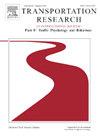Psychometric properties of the peer pressure on risky driving scale in young Chinese drivers and its associations with risky driving behaviours and safe driving climate among friends
IF 3.5
2区 工程技术
Q1 PSYCHOLOGY, APPLIED
Transportation Research Part F-Traffic Psychology and Behaviour
Pub Date : 2025-02-15
DOI:10.1016/j.trf.2025.02.011
引用次数: 0
Abstract
Purpose
The present study aimed to translate and adapt the Peer Pressure on Risky Driving Scale (PPRDS) to young Chinese drivers and examine its relationships with risky driving behaviours and safe driving climate among friends.
Methods
Six hundred sixty drivers aged 18 ∼ 25 years agreed to participate in this study. The measurements included the PPRDS, Safe Driving Climate among Friends Scale (SDCaF) and Risky Driving Behaviour Scale (RDBS).
Results
The results of exploratory factor analysis (n = 323) and confirmatory factor analysis (n = 324) yielded a three-factor scale with 20 items. The three factors are risk-encouraging direct, risk-discouraging direct and indirect peer pressure. The reliability of the PPRDS factors ranged from 0.85 to 0.95. The significant associations among the PPRDS, the SDCaF and the RDBS factors suggested that the PPRDS had acceptable concurrent validity. It also had acceptable convergent validity, with the average variance extracted (AVE) values of the three factors ranging from 0.526 to 0.673. Most importantly, drivers with traffic crash scored significantly higher in terms of risk-encouraging direct and indirect peer pressure than did drivers without traffic crash, indicating that the PPRDS had satisfactory known-group validity.
Conclusion
These findings indicate that the revised PPRDS has satisfactory reliability and validity, making it useful for young driver assessment, classification and testing.
求助全文
约1分钟内获得全文
求助全文
来源期刊
CiteScore
7.60
自引率
14.60%
发文量
239
审稿时长
71 days
期刊介绍:
Transportation Research Part F: Traffic Psychology and Behaviour focuses on the behavioural and psychological aspects of traffic and transport. The aim of the journal is to enhance theory development, improve the quality of empirical studies and to stimulate the application of research findings in practice. TRF provides a focus and a means of communication for the considerable amount of research activities that are now being carried out in this field. The journal provides a forum for transportation researchers, psychologists, ergonomists, engineers and policy-makers with an interest in traffic and transport psychology.

 求助内容:
求助内容: 应助结果提醒方式:
应助结果提醒方式:


